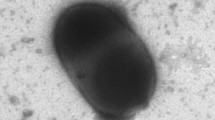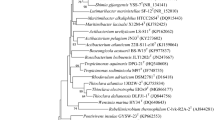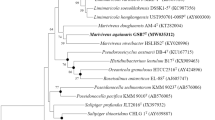Abstract
A novel aerobic, Gram-negative, non-motile, pleomorphic, and rod-shaped bacterium designated KU5D5T was isolated from seawater that was obtained from the coastal region of the Goto Islands, Japan, on the basis of its ability to utilize cyclohexylacetate as the sole source of carbon and energy. Strain KU5D5T grew at pH 6.0–8.0 and 10–35 °C in the presence of 1.0–5.0 % (w/v) NaCl. Analysis of the 16S rRNA gene sequence revealed that this strain was affiliated to the family Rhodobacteraceae in the class Alphaproteobacteria and was related most closely to Lutimaribacter saemankumensis (96.6 % similarity) and Oceanicola pacificus (96.6 %). The predominant respiratory lipoquinone was ubiquinone-10 and the major cellular fatty acids were C18:1 ω7c (66.7 %), C16:0 (7.7 %), C12:1 3-OH (6.1 %), and C17:0 (6.1 %). The DNA G+C content was 58.9 mol %. On the basis of physiological, chemotaxonomic, and phylogenetic data, strain KU5D5T is suggested to represent a novel species of the genus Lutimaribacter, for which the name Lutimaribacter litoralis sp. nov. is proposed. It is also proposed that O. pacificus should be transferred to the genus Lutimaribacter as Lutimaribacter pacificus comb. nov. The type strain of L. litoralis is KU5D5T (=JCM 17792T = KCTC 23660T) and the type strain of L. pacificus is W11-2BT (=CCTCC AB 208224T = LMG 24619T = MCCC 1A01034T).


Similar content being viewed by others
References
Barrow GI, Feltham RKA (1993) Cowan and steel’s manual for the identification of medical bacteria, 3rd edn. Cambridge University Press, Cambridge
Beam HW, Perry JJ (1974) Microbial degradation and assimilation of n-alkyl-substituted cycloparaffins. J Bacteriol 118:394–399
Cowan ST, Steel KJ (1965) Manual for the identification of medical bacteria. Cambridge University Press, London
Dutta TK, Harayama S (2001) Biodegradation of n-alkylcycloalkanes and n-alkylbenzenes via new pathways in Alcanivorax sp. strain MBIC 4326. Appl Environ Microbiol 67:1970–1974
Felsenstein J (1981) Evolutionary trees from DNA sequences: a maximum likelihood approach. J Mol Evol 17:68–376
Felsenstein J (1985) Confidence limits on phylogenies: an approach using the bootstrap. Evolution 39:783–791
Fitch WM (1971) Toward defining the course of evolution: minimum change for a specific tree topology. Syst Zool 20:406–416
Iwaki H, Nakai E, Nakamura S, Hasegawa Y (2008) Isolation and characterization of new cyclohexylacetic acid-degrading bacteria. Curr Microbiol 57:107–110
Iwaki H, Nishimura A, Hasegawa Y (2012) Tropicibacter phthalicus sp. nov., a phthalate-degrading bacterium from seawater. Curr Microbiol 64:392–396
Iwaki H, Takada K, Hasegawa Y (2012) Maricurvus nonylphenolicus gen. nov., sp. nov., a nonylphenol-degrading bacterium isolated from seawater. FEMS Microbiol Lett 327:142–147
Katayama-Fujimura Y, Komatsu Y, Kuraishi H, Kaneko T (1984) Estimation of DNA base composition by high performance liquid chromatography of its nuclease P1 hydrolysate. Agric Biol Chem 48:3169–3172
Kimura M (1980) A simple method of estimating evolutionary rates of base substitutions through comparative studies of nucleotide sequences. J Mol Evol 16:111–120
Koma D, Hasumi F, Chung SY, Kubo M (2003) Biodegradation of n-alkylcyclohexanes by co-oxidation via multiple pathways in Acinetobacter sp. ODDK71. J Biosci Bioeng 95:641–644
Koma D, Sakashita Y, Kubota K, Fujii Y, Hasumi F, Chung SY, Kubo M (2005) Degradation pathways of cyclic alkanes in Rhodococcus sp. NDKK48. Appl Microbiol Biotechnol 66:92–99
Lechner U, Baumbach R, Becker D, Kitunen V, Auling G, Salkinoja-Salonen M (1995) Degradation of 4-chloro-2-methylphenol by an activated sludge isolate and its taxonomic description. Biodegradation 6:83–92
Nakagawa K, Kawasaki H (2001) Determination method of 16S rRNA gene sequence. In: The Society for Actinomycetes (ed.) The isolation and characterization of actinomycetes, Japan: Business Center for Academic Societies, pp.88–117.
Nishijima M, Araki-Sakai M, Sano H (1997) Identification of isoprenoid quinones by frit-FAB liquid chromatography-mass spectrometry for the chemotaxonomy of microorganisms. J Microbiol Methods 28:113–122
Ougham HJ, Trudgill PW (1982) Metabolism of cyclohexaneacetic acid and cyclohexanebutyric acid by Arthrobacter sp. strain CA1. J Bacteriol 150:1172–1182
Perry JJ (1984) Microbial metabolism of cyclic alkanes. In: Atlas RM (ed) Petroleum microbiology. Macmillan, New York, pp 61–98
Saitou N, Nei M (1987) The neighbor-joining method: a new method for reconstructing phylogenetic trees. Mol Biol Evol 4:406–425
Tamura K, Peterson D, Peterson N, Stecher G, Nei M, Kumar S (2011) MEGA5: molecular evolutionary genetics analysis using maximum likelihood, evolutionary distance, and maximum parsimony methods. Mol Biol Evol 28:2731–2739
Tittsler RP, Sandholzer LA (1936) The use of semi-solid agar for the detection of bacterial motility. J Bacteriol 31:575–580
Yakimov MM, Timmis KN, Golyshin PN (2007) Obligate oil-degrading marine bacteria. Curr Opin Biotechnol 18:257–266
Yokota A, Akagawa-Matsushita M, Hiraishi A, Katayama Y, Urakami T, Yamasato K (1992) Distribution of quinone systems in microorganisms: gram-negative eubacteria. Bull Jpn Fed Cult Coll 8:136–171
Yoon J-H, Kang S-J, Lee J-S, Oh T-K (2009) Lutimaribacter saemankumensis gen. nov., sp. nov., isolated from a tidal flat of the Yellow Sea. Int J Syst Evol Microbiol 59:48–52
Yuan J, Lai Q, Wang B, Sun F, Liu X, Du Y, Li G, Gu L, Zheng T, Shao Z (2009) Oceanicola pacificus sp. nov., isolated from a deep-sea pyrene-degrading consortium. Int J Syst Evol Microbiol 59:1158–1161
Acknowledgments
This work was financially supported in part by JSPS KAKENHI Grant Number 22780077 and by the Kansai University Expenditure for Cultivating Young Researchers, 2012.
Author information
Authors and Affiliations
Corresponding author
Rights and permissions
About this article
Cite this article
Iwaki, H., Yasukawa, N., Fujioka, M. et al. Isolation and Characterization of a Marine Cyclohexylacetate-Degrading Bacterium Lutimaribacter litoralis sp. nov., and Reclassification of Oceanicola pacificus as Lutimaribacter pacificus comb. nov.. Curr Microbiol 66, 588–593 (2013). https://doi.org/10.1007/s00284-013-0321-x
Received:
Accepted:
Published:
Issue Date:
DOI: https://doi.org/10.1007/s00284-013-0321-x




